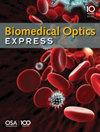用于测量多种荧光团浓度的微型多分色仪器
IF 2.9
2区 医学
Q2 BIOCHEMICAL RESEARCH METHODS
引用次数: 0
摘要
在脑部切除术中确定肿瘤边缘对改善术后效果至关重要。由于多形性胶质母细胞瘤(GBM)具有高度浸润性,而术中对肿瘤边缘的观察有限,据观察,高达 80% 的 GBM 病例会出现手术切除不彻底的情况,导致几乎普遍的肿瘤复发和中位生存期仅为 14.6 个月的不良预后。这项研究提出了一种基于 SiPMT 的微型光学系统,可同时测量用于脑肿瘤检测的强 DRS 和弱自发荧光。光学元件的微型化将八个选择波长的空间分离限制在 1.5 × 2 × 16 毫米的尺寸内。由于体积小,这项技术可以与手术室现有的手术引导仪器集成。与动态范围有限和积分时间较长的光谱仪系统相比,该系统能够动态地减去任何背景光照,并在从 pW 到 mWs 的宽范围内测量信号强度,因此更适合临床环境。使用含有混合荧光团的光学组织模型进行的测量表明,使用 PLS 回归法,NADH、FAD 和 PpIX 的拟合响应与实际浓度之间的相关系数分别为 0.95、0.87 和 0.97。这些令人鼓舞的结果表明,我们提出的微型仪器可作为手术室的有效替代品,协助外科医生识别脑肿瘤,为患者带来积极的手术效果。本文章由计算机程序翻译,如有差异,请以英文原文为准。
Miniature, multi-dichroic instrument for measuring the concentration of multiple fluorophores
Identification of tumour margins during resection of the brain is critical for improving the post-operative outcomes. Due to the highly infiltrative nature of glioblastoma multiforme (GBM) and limited intraoperative visualization of the tumour margin, incomplete surgical resection has been observed to occur in up to 80 % of GBM cases, leading to nearly universal tumour recurrence and overall poor prognosis of 14.6 months median survival. This research presents a miniaturized, SiPMT-based optical system for simultaneous measurement of powerful DRS and weak auto-fluorescence for brain tumour detection. The miniaturisation of the optical elements confined the spatial separation of eight select wavelengths into footprint measuring 1.5 × 2 × 16 mm. The small footprint enables this technology to be integrated with existing surgical guidance instruments in the operating room. It’s dynamic ability to subtract any background illumination and measure signal intensities across a broad range from pW to mWs make this design much more suitable for clinical environments as compared to spectrometer-based systems with limited dynamic ranges and high integration times. Measurements using optical tissue phantoms containing mixed fluorophores demonstrate correlation coefficients between the fitted response and actual concentration using PLS regression being 0.95, 0.87 and 0.97 for NADH, FAD and PpIX , respectively. These promising results indicate that our proposed miniaturized instrument could serve as an effective alternative in operating rooms, assisting surgeons in identifying brain tumours to achieving positive surgical outcomes for patients.
求助全文
通过发布文献求助,成功后即可免费获取论文全文。
去求助
来源期刊

Biomedical optics express
BIOCHEMICAL RESEARCH METHODS-OPTICS
CiteScore
6.80
自引率
11.80%
发文量
633
审稿时长
1 months
期刊介绍:
The journal''s scope encompasses fundamental research, technology development, biomedical studies and clinical applications. BOEx focuses on the leading edge topics in the field, including:
Tissue optics and spectroscopy
Novel microscopies
Optical coherence tomography
Diffuse and fluorescence tomography
Photoacoustic and multimodal imaging
Molecular imaging and therapies
Nanophotonic biosensing
Optical biophysics/photobiology
Microfluidic optical devices
Vision research.
 求助内容:
求助内容: 应助结果提醒方式:
应助结果提醒方式:


